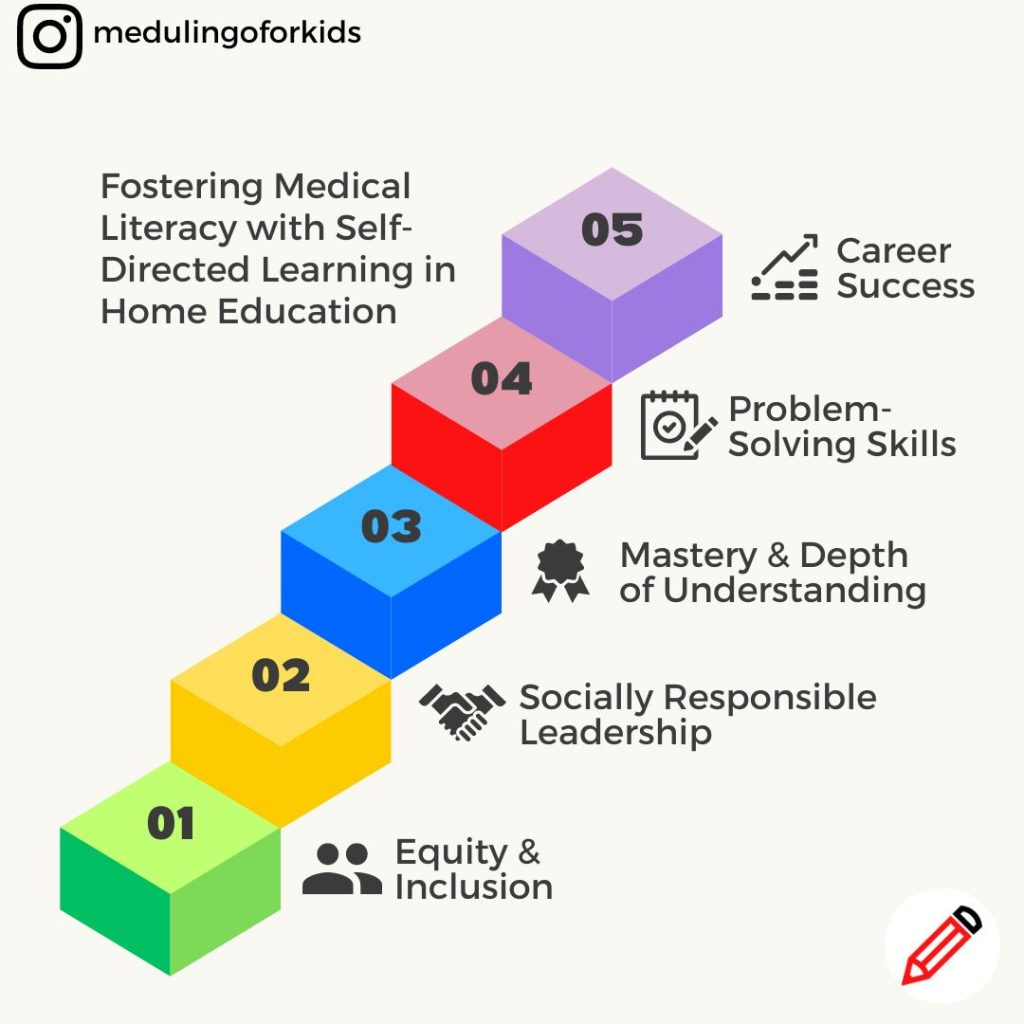In home education, embracing self-directed learning emerges as a transformative approach for developing medical literacy among students. Medical literacy encompasses the ability to access, understand, evaluate, and apply health information effectively—an essential skillset for navigating the complexities of healthcare and making informed decisions about one’s well-being. By empowering homeschoolers with opportunities for self-directed learning, educators foster mastery, problem-solving skills, career success, and equity in medical literacy development. This article explores the compelling benefits of self-directed learning and its pivotal role in nurturing socially responsible, empathetic leaders in healthcare.

1. Mastery and Depth of Understanding:
Self-directed learning allows homeschoolers to delve deeply into medical topics that pique their interest and curiosity. By taking ownership of their learning journey, students can explore medical concepts at their own pace, diving into areas of particular interest and uncovering connections between different aspects of healthcare. Through self-directed exploration, students attain a level of mastery and depth of understanding that goes beyond surface-level knowledge. This deeper understanding lays the groundwork for lifelong learning and critical thinking in medical literacy development.
2. Cultivating Problem-Solving Skills:
Self-directed learning fosters the development of critical thinking and problem-solving skills essential for navigating healthcare challenges. Homeschoolers engage in inquiry-based learning experiences, tackling complex medical issues, analyzing evidence, and proposing solutions. By grappling with real-world healthcare scenarios, students develop literacy, adaptability, and creative problem-solving abilities. Self-directed learners develop medical literacy from multiple perspectives, honing their ability to evaluate information critically and make informed decisions in healthcare contexts.
3. Enhancing Career Success:
The skills and competencies cultivated through self-directed learning are highly transferable and valuable in a variety of career paths, including those within the healthcare sector. Homeschoolers who engage in self-directed learning develop self-discipline, initiative, and the ability to set and achieve goals—attributes that are highly sought after by employers in the healthcare industry. By fostering a culture of self-directed learning, home educators prepare students for success in future healthcare careers, equipping them with the skills and mindset necessary to thrive in a rapidly evolving healthcare landscape.
4. Promoting Equity and Inclusion:
Equity lies at the heart of effective medical literacy development. Self-directed learning ensures that every homeschooler has access to quality educational resources and opportunities for growth, regardless of background or circumstances. By allowing students to pursue their interests and passions autonomously, educators promote equity and inclusion in medical literacy development. Self-directed learning empowers students from diverse backgrounds to explore healthcare topics that resonate with their experiences and aspirations, fostering a sense of belonging and ownership in their learning journey.
5. Fostering Socially Responsible Leadership:
Medical literacy must extend beyond the acquisition of knowledge and skills—it must produce socially responsible, empathetic leaders who advocate for health equity and well-being in their communities. Self-directed learning nurtures the development of empathetic leaders who understand the social determinants of health and advocate for health equity. By engaging in self-directed inquiry and exploration, homeschoolers gain a deeper understanding of healthcare disparities, cultural competence, and the importance of social justice in healthcare delivery. Self-directed learners emerge as advocates for health equity, working towards a future where access to quality healthcare is a fundamental human right.
Foster Medical Literacy with Self-Directed Learning in Home Education
In conclusion, self-directed learning is a powerful approach for homeschoolers developing medical literacy, offering benefits that extend far beyond the acquisition of knowledge. By fostering mastery, problem-solving skills, career success, and equity, self-directed learning empowers students to become socially responsible, empathetic leaders in healthcare. As home educators embrace the principles of self-directed learning, they equip students with the tools and mindset necessary to navigate the complexities of healthcare and make meaningful contributions to the well-being of individuals and communities alike.
===
Interested in teaching medical literacy pain free? Shop medical literacy resources!

This article was drafted by ChatGPT and edited by Joan Lee Tu, the founder of MedULingo.com.
You may also be interested in the following articles:
The Benefits of Medical Literacy Resources for Home Education Students
Exploring Medical Fields: Strategies for Home Education Students
The Importance of Multiple Learning Modalities for Medical Literacy in Home Education
How To Empower Future STEM Innovators With Self Directed Learning in Medical Literacy
Fostering Medical Literacy with Self-Directed Learning in Home Education
How Medical Literacy Activity Books Empower Learners in STEM Education

